The Impact of E-commerce on International Ports and Singapore Port
VerifiedAdded on 2023/04/07
|17
|2632
|377
Report
AI Summary
This report investigates the substantial influence of e-commerce on international ports, with a specific emphasis on the Port of Singapore. The analysis encompasses various aspects, including the evolving trade patterns, fluctuations in cargo volume, and the dynamics of transshipment cargo. Furthermore, the report delves into the development of the port industry, assessing its adaptation to e-commerce driven changes, and examines the resulting shifts in port competition and competitiveness. The study highlights the strategic implementations by the Port of Singapore and discusses its future strategies. The report uses data and information in tables, charts, and includes a complete list of references to provide a comprehensive understanding of the e-commerce impact on the maritime industry and the Port of Singapore. The research underscores the transformative role of e-commerce in reshaping global trade and port operations.
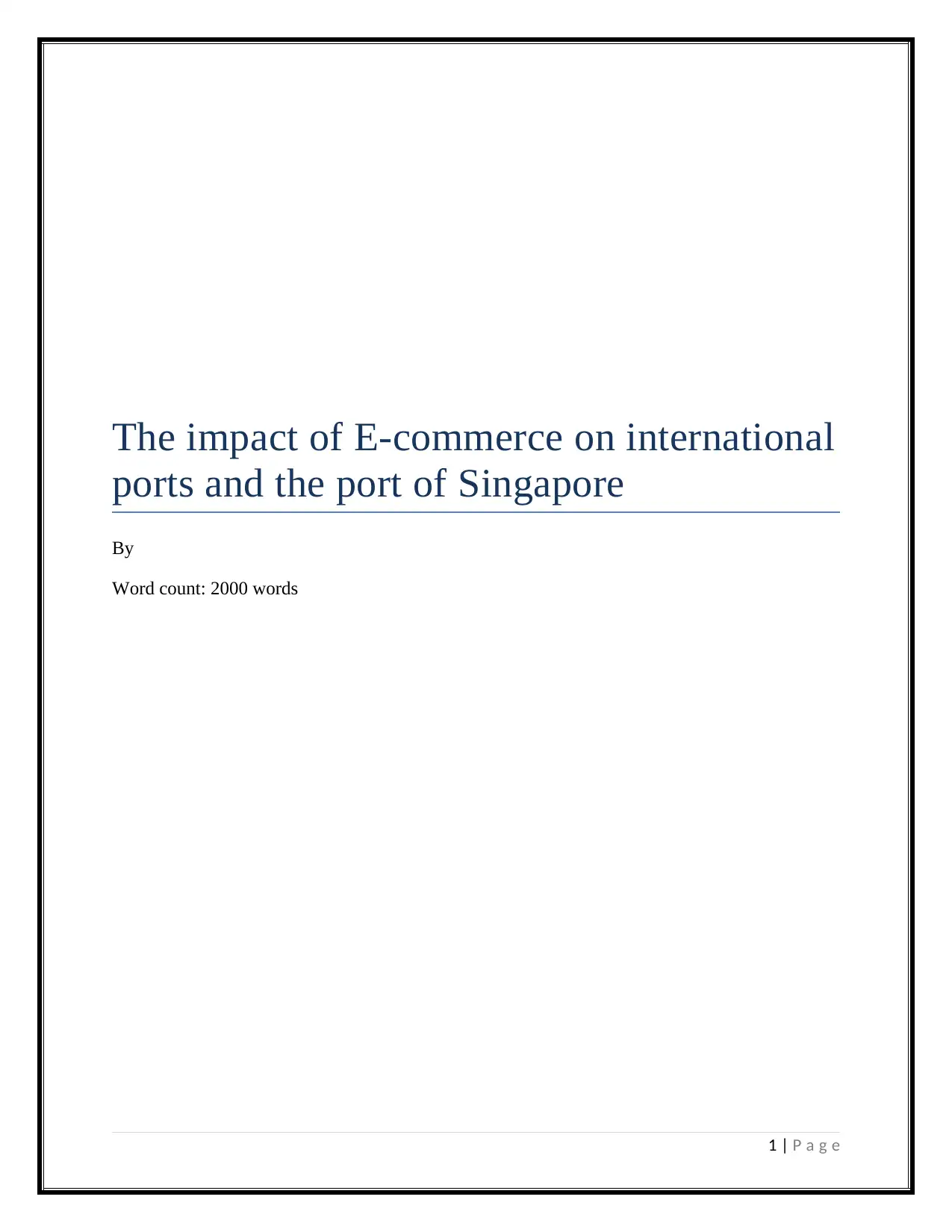
The impact of E-commerce on international
ports and the port of Singapore
By
Word count: 2000 words
1 | P a g e
ports and the port of Singapore
By
Word count: 2000 words
1 | P a g e
Paraphrase This Document
Need a fresh take? Get an instant paraphrase of this document with our AI Paraphraser

Table of Contents
Introduction......................................................................................................................................3
Ecommerce......................................................................................................................................3
The impact of E-commerce on international ports in general.........................................................3
New markets................................................................................................................................4
Trade pattern................................................................................................................................5
Cargo volume...............................................................................................................................6
Transshipment cargo volume.......................................................................................................8
Port industry development...........................................................................................................8
Port competition and competitiveness.......................................................................................10
The impact of E-commerce on the port of Singapore....................................................................11
Singapore ports..........................................................................................................................12
Conclusion.....................................................................................................................................13
Bibliography..................................................................................................................................15
2 | P a g e
Introduction......................................................................................................................................3
Ecommerce......................................................................................................................................3
The impact of E-commerce on international ports in general.........................................................3
New markets................................................................................................................................4
Trade pattern................................................................................................................................5
Cargo volume...............................................................................................................................6
Transshipment cargo volume.......................................................................................................8
Port industry development...........................................................................................................8
Port competition and competitiveness.......................................................................................10
The impact of E-commerce on the port of Singapore....................................................................11
Singapore ports..........................................................................................................................12
Conclusion.....................................................................................................................................13
Bibliography..................................................................................................................................15
2 | P a g e
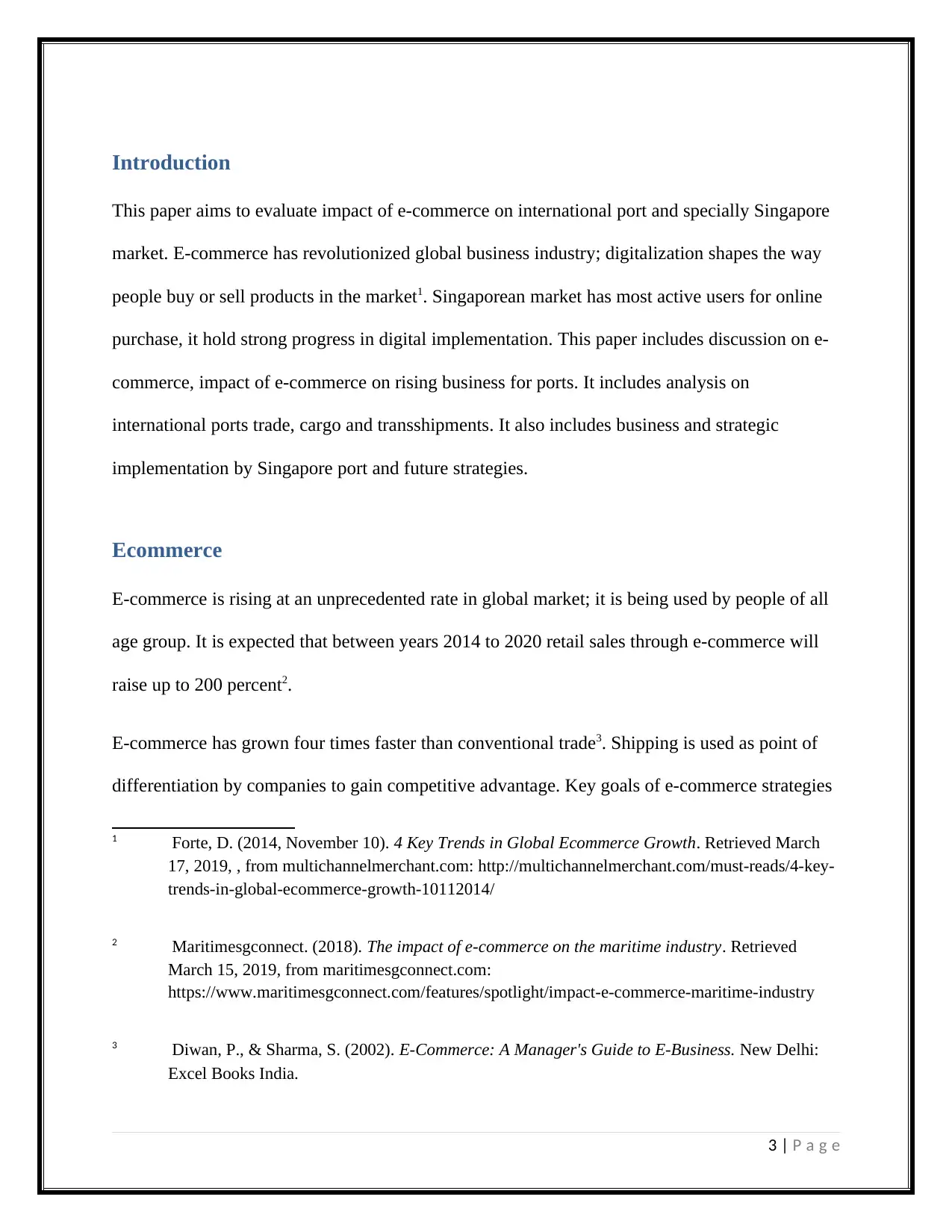
Introduction
This paper aims to evaluate impact of e-commerce on international port and specially Singapore
market. E-commerce has revolutionized global business industry; digitalization shapes the way
people buy or sell products in the market1. Singaporean market has most active users for online
purchase, it hold strong progress in digital implementation. This paper includes discussion on e-
commerce, impact of e-commerce on rising business for ports. It includes analysis on
international ports trade, cargo and transshipments. It also includes business and strategic
implementation by Singapore port and future strategies.
Ecommerce
E-commerce is rising at an unprecedented rate in global market; it is being used by people of all
age group. It is expected that between years 2014 to 2020 retail sales through e-commerce will
raise up to 200 percent2.
E-commerce has grown four times faster than conventional trade3. Shipping is used as point of
differentiation by companies to gain competitive advantage. Key goals of e-commerce strategies
1 Forte, D. (2014, November 10). 4 Key Trends in Global Ecommerce Growth. Retrieved March
17, 2019, , from multichannelmerchant.com: http://multichannelmerchant.com/must-reads/4-key-
trends-in-global-ecommerce-growth-10112014/
2 Maritimesgconnect. (2018). The impact of e-commerce on the maritime industry. Retrieved
March 15, 2019, from maritimesgconnect.com:
https://www.maritimesgconnect.com/features/spotlight/impact-e-commerce-maritime-industry
3 Diwan, P., & Sharma, S. (2002). E-Commerce: A Manager's Guide to E-Business. New Delhi:
Excel Books India.
3 | P a g e
This paper aims to evaluate impact of e-commerce on international port and specially Singapore
market. E-commerce has revolutionized global business industry; digitalization shapes the way
people buy or sell products in the market1. Singaporean market has most active users for online
purchase, it hold strong progress in digital implementation. This paper includes discussion on e-
commerce, impact of e-commerce on rising business for ports. It includes analysis on
international ports trade, cargo and transshipments. It also includes business and strategic
implementation by Singapore port and future strategies.
Ecommerce
E-commerce is rising at an unprecedented rate in global market; it is being used by people of all
age group. It is expected that between years 2014 to 2020 retail sales through e-commerce will
raise up to 200 percent2.
E-commerce has grown four times faster than conventional trade3. Shipping is used as point of
differentiation by companies to gain competitive advantage. Key goals of e-commerce strategies
1 Forte, D. (2014, November 10). 4 Key Trends in Global Ecommerce Growth. Retrieved March
17, 2019, , from multichannelmerchant.com: http://multichannelmerchant.com/must-reads/4-key-
trends-in-global-ecommerce-growth-10112014/
2 Maritimesgconnect. (2018). The impact of e-commerce on the maritime industry. Retrieved
March 15, 2019, from maritimesgconnect.com:
https://www.maritimesgconnect.com/features/spotlight/impact-e-commerce-maritime-industry
3 Diwan, P., & Sharma, S. (2002). E-Commerce: A Manager's Guide to E-Business. New Delhi:
Excel Books India.
3 | P a g e
⊘ This is a preview!⊘
Do you want full access?
Subscribe today to unlock all pages.

Trusted by 1+ million students worldwide
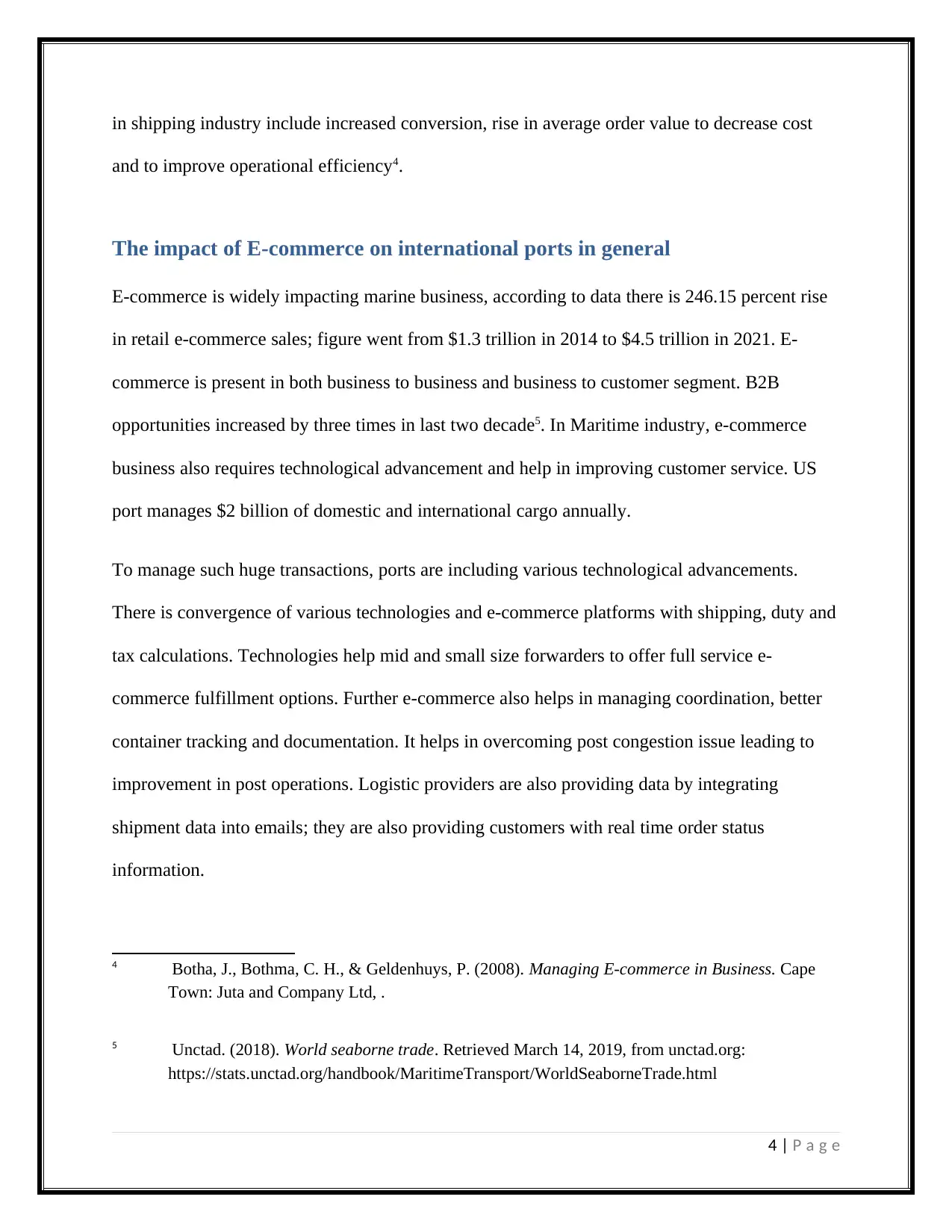
in shipping industry include increased conversion, rise in average order value to decrease cost
and to improve operational efficiency4.
The impact of E-commerce on international ports in general
E-commerce is widely impacting marine business, according to data there is 246.15 percent rise
in retail e-commerce sales; figure went from $1.3 trillion in 2014 to $4.5 trillion in 2021. E-
commerce is present in both business to business and business to customer segment. B2B
opportunities increased by three times in last two decade5. In Maritime industry, e-commerce
business also requires technological advancement and help in improving customer service. US
port manages $2 billion of domestic and international cargo annually.
To manage such huge transactions, ports are including various technological advancements.
There is convergence of various technologies and e-commerce platforms with shipping, duty and
tax calculations. Technologies help mid and small size forwarders to offer full service e-
commerce fulfillment options. Further e-commerce also helps in managing coordination, better
container tracking and documentation. It helps in overcoming post congestion issue leading to
improvement in post operations. Logistic providers are also providing data by integrating
shipment data into emails; they are also providing customers with real time order status
information.
4 Botha, J., Bothma, C. H., & Geldenhuys, P. (2008). Managing E-commerce in Business. Cape
Town: Juta and Company Ltd, .
5 Unctad. (2018). World seaborne trade. Retrieved March 14, 2019, from unctad.org:
https://stats.unctad.org/handbook/MaritimeTransport/WorldSeaborneTrade.html
4 | P a g e
and to improve operational efficiency4.
The impact of E-commerce on international ports in general
E-commerce is widely impacting marine business, according to data there is 246.15 percent rise
in retail e-commerce sales; figure went from $1.3 trillion in 2014 to $4.5 trillion in 2021. E-
commerce is present in both business to business and business to customer segment. B2B
opportunities increased by three times in last two decade5. In Maritime industry, e-commerce
business also requires technological advancement and help in improving customer service. US
port manages $2 billion of domestic and international cargo annually.
To manage such huge transactions, ports are including various technological advancements.
There is convergence of various technologies and e-commerce platforms with shipping, duty and
tax calculations. Technologies help mid and small size forwarders to offer full service e-
commerce fulfillment options. Further e-commerce also helps in managing coordination, better
container tracking and documentation. It helps in overcoming post congestion issue leading to
improvement in post operations. Logistic providers are also providing data by integrating
shipment data into emails; they are also providing customers with real time order status
information.
4 Botha, J., Bothma, C. H., & Geldenhuys, P. (2008). Managing E-commerce in Business. Cape
Town: Juta and Company Ltd, .
5 Unctad. (2018). World seaborne trade. Retrieved March 14, 2019, from unctad.org:
https://stats.unctad.org/handbook/MaritimeTransport/WorldSeaborneTrade.html
4 | P a g e
Paraphrase This Document
Need a fresh take? Get an instant paraphrase of this document with our AI Paraphraser
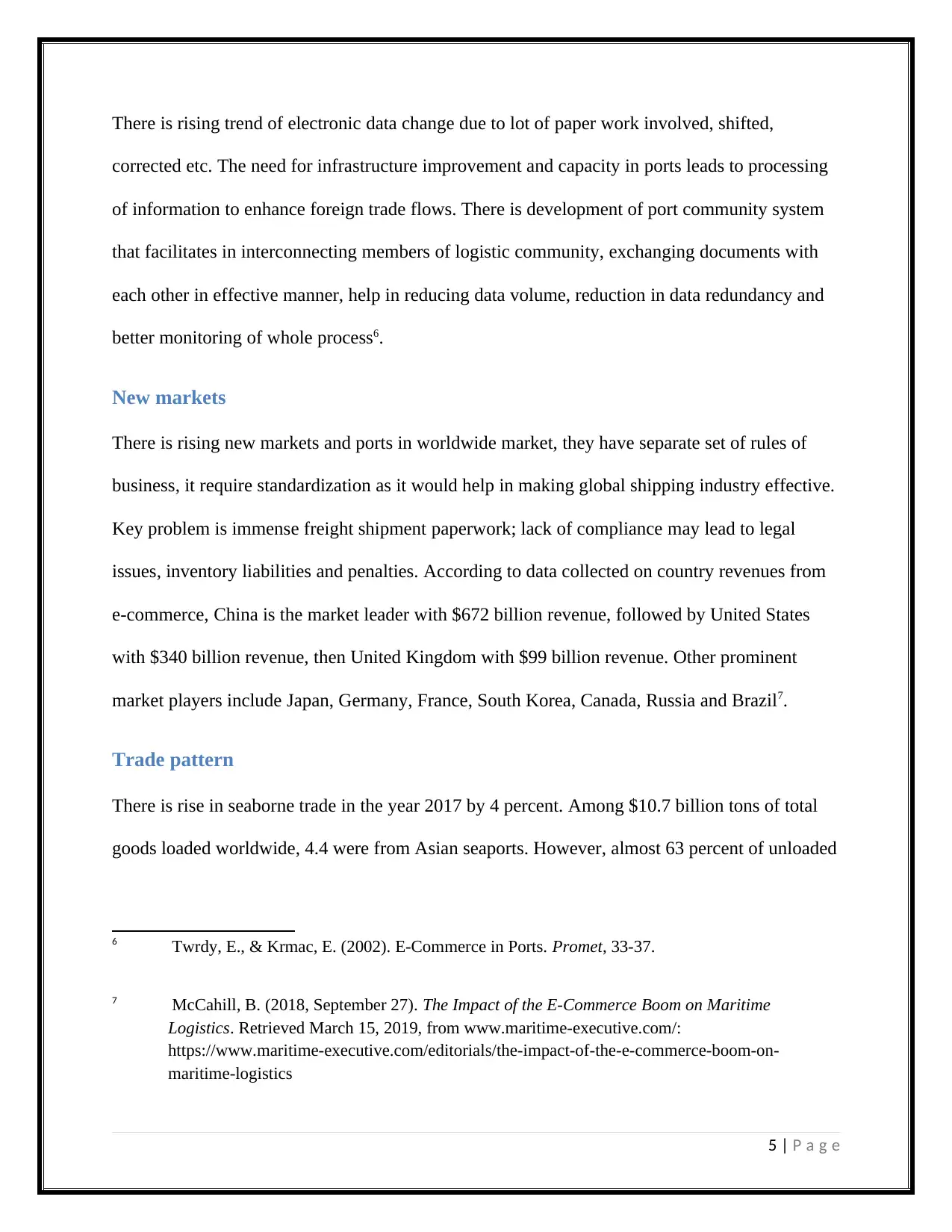
There is rising trend of electronic data change due to lot of paper work involved, shifted,
corrected etc. The need for infrastructure improvement and capacity in ports leads to processing
of information to enhance foreign trade flows. There is development of port community system
that facilitates in interconnecting members of logistic community, exchanging documents with
each other in effective manner, help in reducing data volume, reduction in data redundancy and
better monitoring of whole process6.
New markets
There is rising new markets and ports in worldwide market, they have separate set of rules of
business, it require standardization as it would help in making global shipping industry effective.
Key problem is immense freight shipment paperwork; lack of compliance may lead to legal
issues, inventory liabilities and penalties. According to data collected on country revenues from
e-commerce, China is the market leader with $672 billion revenue, followed by United States
with $340 billion revenue, then United Kingdom with $99 billion revenue. Other prominent
market players include Japan, Germany, France, South Korea, Canada, Russia and Brazil7.
Trade pattern
There is rise in seaborne trade in the year 2017 by 4 percent. Among $10.7 billion tons of total
goods loaded worldwide, 4.4 were from Asian seaports. However, almost 63 percent of unloaded
6 Twrdy, E., & Krmac, E. (2002). E-Commerce in Ports. Promet, 33-37.
7 McCahill, B. (2018, September 27). The Impact of the E-Commerce Boom on Maritime
Logistics. Retrieved March 15, 2019, from www.maritime-executive.com/:
https://www.maritime-executive.com/editorials/the-impact-of-the-e-commerce-boom-on-
maritime-logistics
5 | P a g e
corrected etc. The need for infrastructure improvement and capacity in ports leads to processing
of information to enhance foreign trade flows. There is development of port community system
that facilitates in interconnecting members of logistic community, exchanging documents with
each other in effective manner, help in reducing data volume, reduction in data redundancy and
better monitoring of whole process6.
New markets
There is rising new markets and ports in worldwide market, they have separate set of rules of
business, it require standardization as it would help in making global shipping industry effective.
Key problem is immense freight shipment paperwork; lack of compliance may lead to legal
issues, inventory liabilities and penalties. According to data collected on country revenues from
e-commerce, China is the market leader with $672 billion revenue, followed by United States
with $340 billion revenue, then United Kingdom with $99 billion revenue. Other prominent
market players include Japan, Germany, France, South Korea, Canada, Russia and Brazil7.
Trade pattern
There is rise in seaborne trade in the year 2017 by 4 percent. Among $10.7 billion tons of total
goods loaded worldwide, 4.4 were from Asian seaports. However, almost 63 percent of unloaded
6 Twrdy, E., & Krmac, E. (2002). E-Commerce in Ports. Promet, 33-37.
7 McCahill, B. (2018, September 27). The Impact of the E-Commerce Boom on Maritime
Logistics. Retrieved March 15, 2019, from www.maritime-executive.com/:
https://www.maritime-executive.com/editorials/the-impact-of-the-e-commerce-boom-on-
maritime-logistics
5 | P a g e
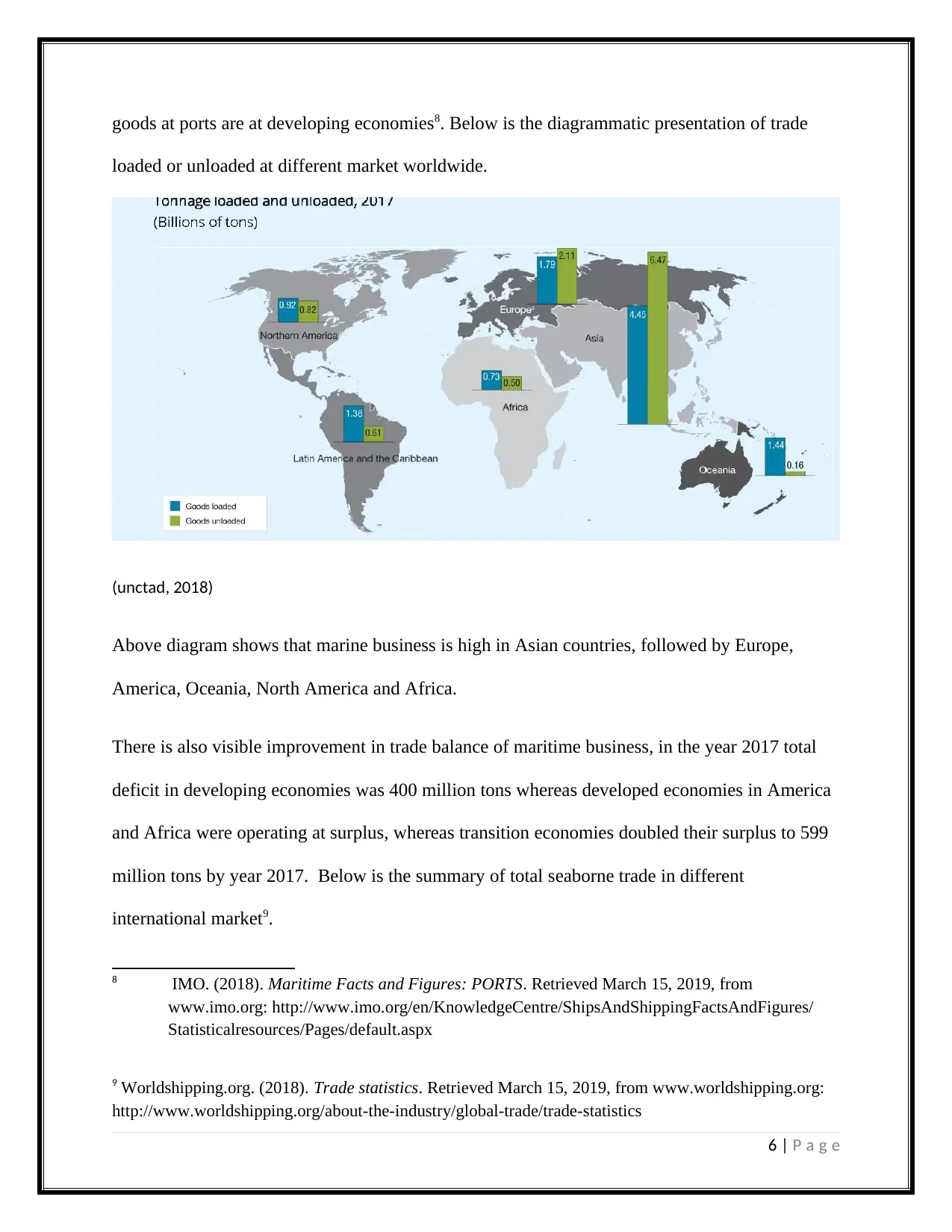
goods at ports are at developing economies8. Below is the diagrammatic presentation of trade
loaded or unloaded at different market worldwide.
(unctad, 2018)
Above diagram shows that marine business is high in Asian countries, followed by Europe,
America, Oceania, North America and Africa.
There is also visible improvement in trade balance of maritime business, in the year 2017 total
deficit in developing economies was 400 million tons whereas developed economies in America
and Africa were operating at surplus, whereas transition economies doubled their surplus to 599
million tons by year 2017. Below is the summary of total seaborne trade in different
international market9.
8 IMO. (2018). Maritime Facts and Figures: PORTS. Retrieved March 15, 2019, from
www.imo.org: http://www.imo.org/en/KnowledgeCentre/ShipsAndShippingFactsAndFigures/
Statisticalresources/Pages/default.aspx
9 Worldshipping.org. (2018). Trade statistics. Retrieved March 15, 2019, from www.worldshipping.org:
http://www.worldshipping.org/about-the-industry/global-trade/trade-statistics
6 | P a g e
loaded or unloaded at different market worldwide.
(unctad, 2018)
Above diagram shows that marine business is high in Asian countries, followed by Europe,
America, Oceania, North America and Africa.
There is also visible improvement in trade balance of maritime business, in the year 2017 total
deficit in developing economies was 400 million tons whereas developed economies in America
and Africa were operating at surplus, whereas transition economies doubled their surplus to 599
million tons by year 2017. Below is the summary of total seaborne trade in different
international market9.
8 IMO. (2018). Maritime Facts and Figures: PORTS. Retrieved March 15, 2019, from
www.imo.org: http://www.imo.org/en/KnowledgeCentre/ShipsAndShippingFactsAndFigures/
Statisticalresources/Pages/default.aspx
9 Worldshipping.org. (2018). Trade statistics. Retrieved March 15, 2019, from www.worldshipping.org:
http://www.worldshipping.org/about-the-industry/global-trade/trade-statistics
6 | P a g e
⊘ This is a preview!⊘
Do you want full access?
Subscribe today to unlock all pages.

Trusted by 1+ million students worldwide
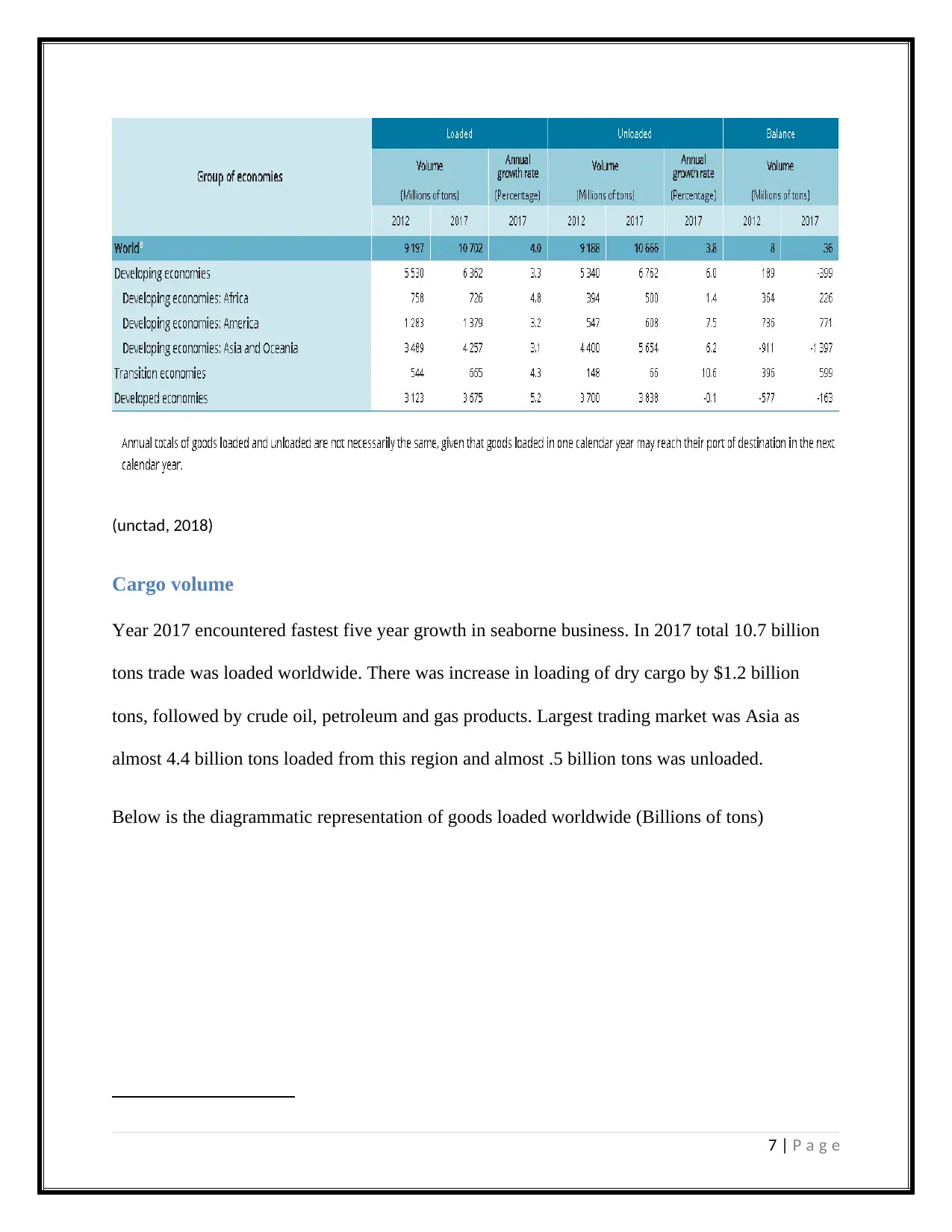
(unctad, 2018)
Cargo volume
Year 2017 encountered fastest five year growth in seaborne business. In 2017 total 10.7 billion
tons trade was loaded worldwide. There was increase in loading of dry cargo by $1.2 billion
tons, followed by crude oil, petroleum and gas products. Largest trading market was Asia as
almost 4.4 billion tons loaded from this region and almost .5 billion tons was unloaded.
Below is the diagrammatic representation of goods loaded worldwide (Billions of tons)
7 | P a g e
Cargo volume
Year 2017 encountered fastest five year growth in seaborne business. In 2017 total 10.7 billion
tons trade was loaded worldwide. There was increase in loading of dry cargo by $1.2 billion
tons, followed by crude oil, petroleum and gas products. Largest trading market was Asia as
almost 4.4 billion tons loaded from this region and almost .5 billion tons was unloaded.
Below is the diagrammatic representation of goods loaded worldwide (Billions of tons)
7 | P a g e
Paraphrase This Document
Need a fresh take? Get an instant paraphrase of this document with our AI Paraphraser
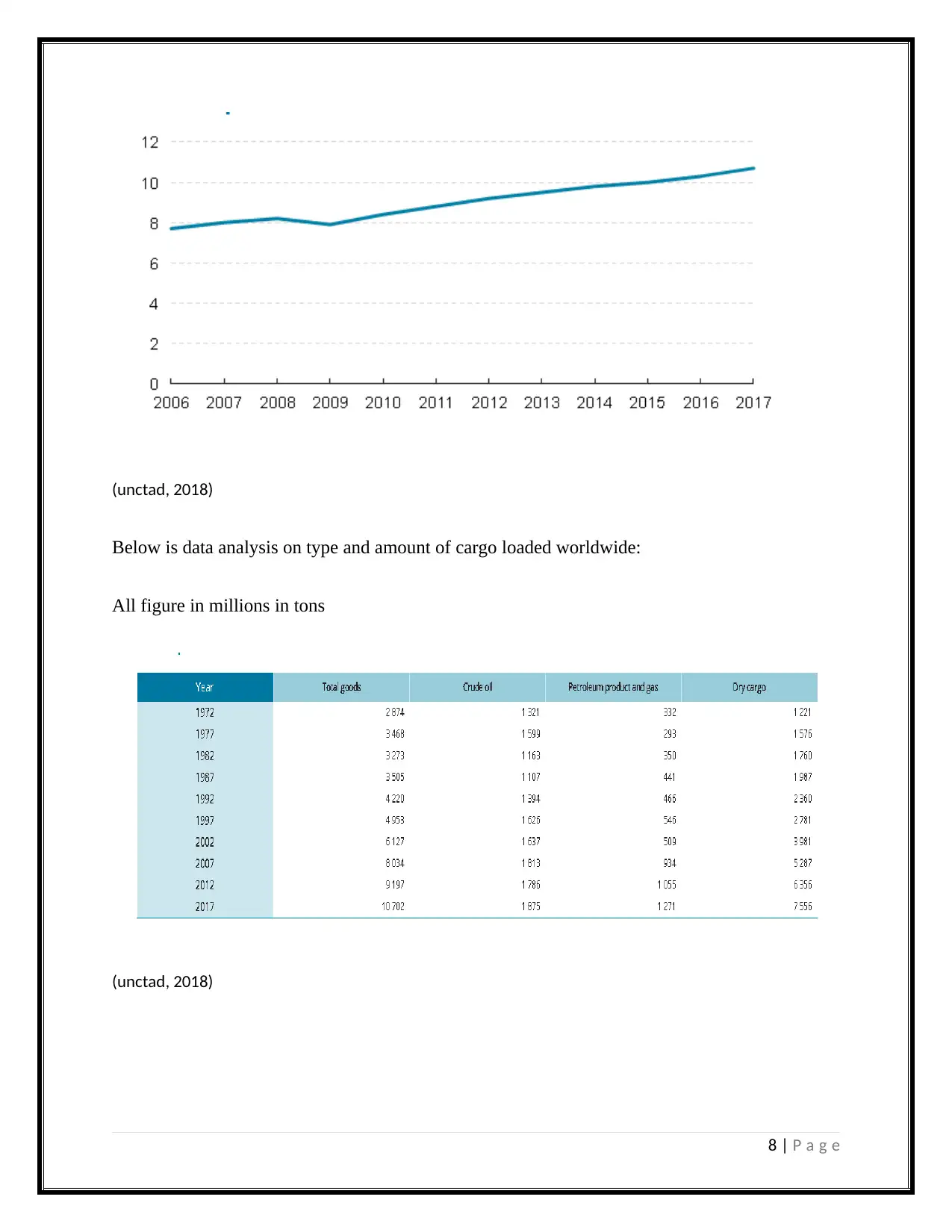
(unctad, 2018)
Below is data analysis on type and amount of cargo loaded worldwide:
All figure in millions in tons
(unctad, 2018)
8 | P a g e
Below is data analysis on type and amount of cargo loaded worldwide:
All figure in millions in tons
(unctad, 2018)
8 | P a g e
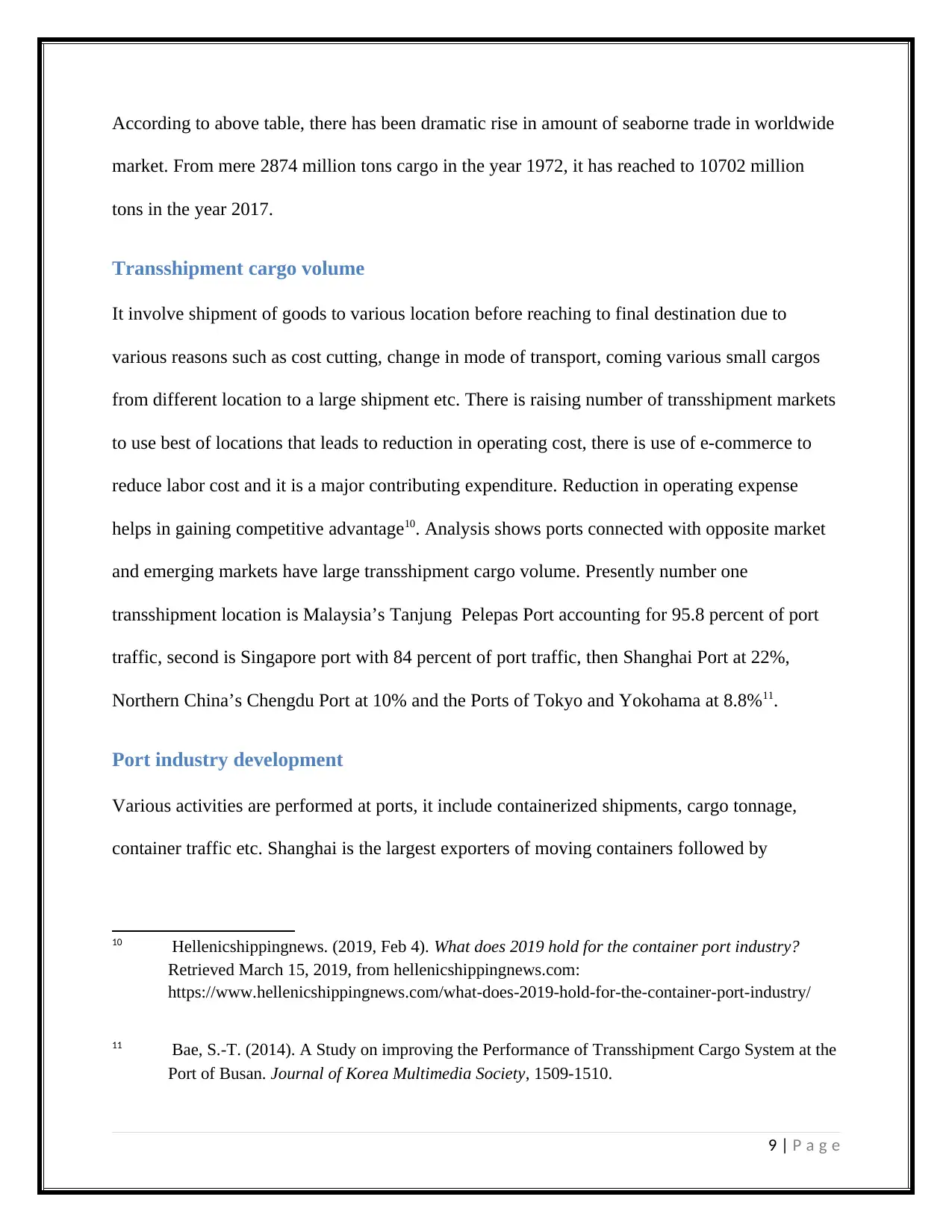
According to above table, there has been dramatic rise in amount of seaborne trade in worldwide
market. From mere 2874 million tons cargo in the year 1972, it has reached to 10702 million
tons in the year 2017.
Transshipment cargo volume
It involve shipment of goods to various location before reaching to final destination due to
various reasons such as cost cutting, change in mode of transport, coming various small cargos
from different location to a large shipment etc. There is raising number of transshipment markets
to use best of locations that leads to reduction in operating cost, there is use of e-commerce to
reduce labor cost and it is a major contributing expenditure. Reduction in operating expense
helps in gaining competitive advantage10. Analysis shows ports connected with opposite market
and emerging markets have large transshipment cargo volume. Presently number one
transshipment location is Malaysia’s Tanjung Pelepas Port accounting for 95.8 percent of port
traffic, second is Singapore port with 84 percent of port traffic, then Shanghai Port at 22%,
Northern China’s Chengdu Port at 10% and the Ports of Tokyo and Yokohama at 8.8%11.
Port industry development
Various activities are performed at ports, it include containerized shipments, cargo tonnage,
container traffic etc. Shanghai is the largest exporters of moving containers followed by
10 Hellenicshippingnews. (2019, Feb 4). What does 2019 hold for the container port industry?
Retrieved March 15, 2019, from hellenicshippingnews.com:
https://www.hellenicshippingnews.com/what-does-2019-hold-for-the-container-port-industry/
11 Bae, S.-T. (2014). A Study on improving the Performance of Transshipment Cargo System at the
Port of Busan. Journal of Korea Multimedia Society, 1509-1510.
9 | P a g e
market. From mere 2874 million tons cargo in the year 1972, it has reached to 10702 million
tons in the year 2017.
Transshipment cargo volume
It involve shipment of goods to various location before reaching to final destination due to
various reasons such as cost cutting, change in mode of transport, coming various small cargos
from different location to a large shipment etc. There is raising number of transshipment markets
to use best of locations that leads to reduction in operating cost, there is use of e-commerce to
reduce labor cost and it is a major contributing expenditure. Reduction in operating expense
helps in gaining competitive advantage10. Analysis shows ports connected with opposite market
and emerging markets have large transshipment cargo volume. Presently number one
transshipment location is Malaysia’s Tanjung Pelepas Port accounting for 95.8 percent of port
traffic, second is Singapore port with 84 percent of port traffic, then Shanghai Port at 22%,
Northern China’s Chengdu Port at 10% and the Ports of Tokyo and Yokohama at 8.8%11.
Port industry development
Various activities are performed at ports, it include containerized shipments, cargo tonnage,
container traffic etc. Shanghai is the largest exporters of moving containers followed by
10 Hellenicshippingnews. (2019, Feb 4). What does 2019 hold for the container port industry?
Retrieved March 15, 2019, from hellenicshippingnews.com:
https://www.hellenicshippingnews.com/what-does-2019-hold-for-the-container-port-industry/
11 Bae, S.-T. (2014). A Study on improving the Performance of Transshipment Cargo System at the
Port of Busan. Journal of Korea Multimedia Society, 1509-1510.
9 | P a g e
⊘ This is a preview!⊘
Do you want full access?
Subscribe today to unlock all pages.

Trusted by 1+ million students worldwide
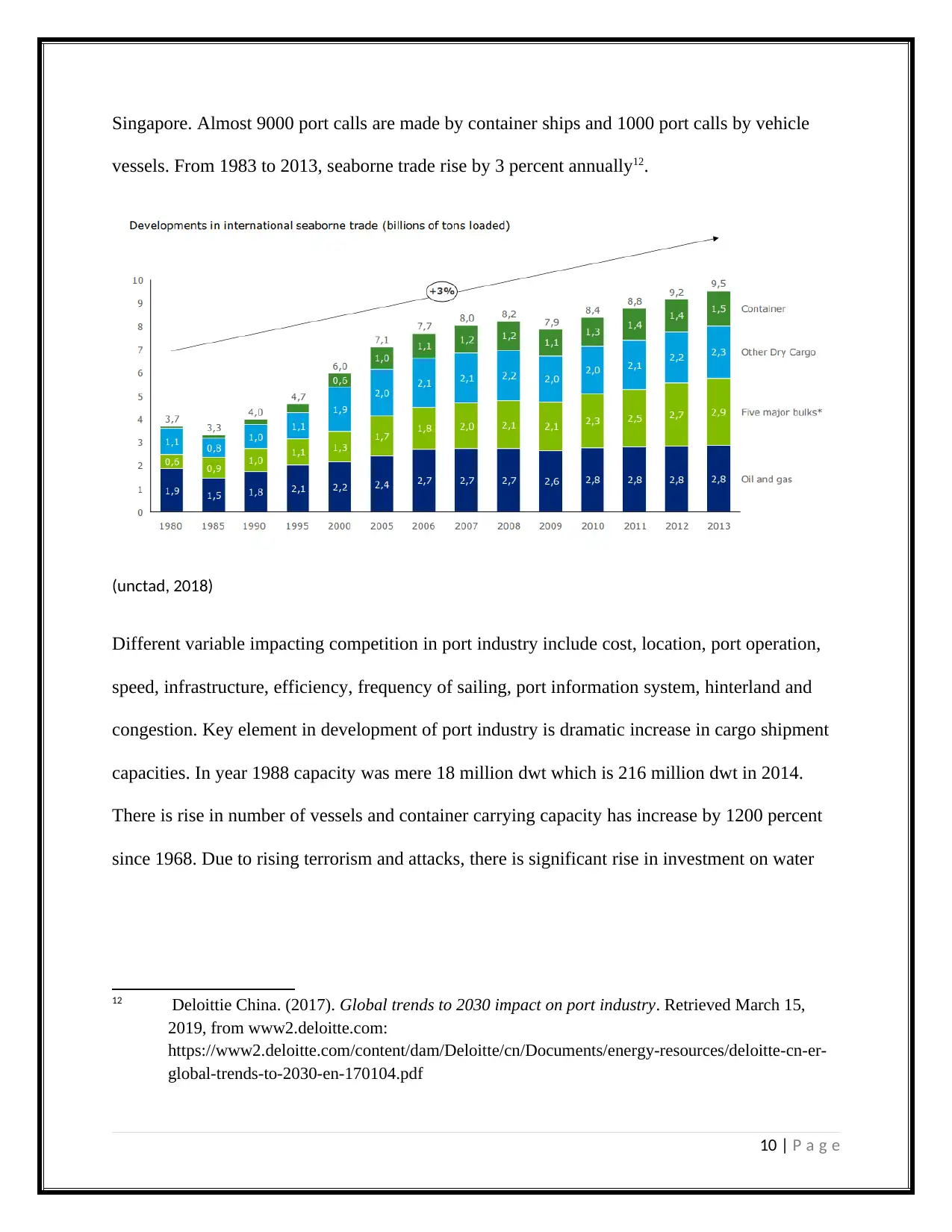
Singapore. Almost 9000 port calls are made by container ships and 1000 port calls by vehicle
vessels. From 1983 to 2013, seaborne trade rise by 3 percent annually12.
(unctad, 2018)
Different variable impacting competition in port industry include cost, location, port operation,
speed, infrastructure, efficiency, frequency of sailing, port information system, hinterland and
congestion. Key element in development of port industry is dramatic increase in cargo shipment
capacities. In year 1988 capacity was mere 18 million dwt which is 216 million dwt in 2014.
There is rise in number of vessels and container carrying capacity has increase by 1200 percent
since 1968. Due to rising terrorism and attacks, there is significant rise in investment on water
12 Deloittie China. (2017). Global trends to 2030 impact on port industry. Retrieved March 15,
2019, from www2.deloitte.com:
https://www2.deloitte.com/content/dam/Deloitte/cn/Documents/energy-resources/deloitte-cn-er-
global-trends-to-2030-en-170104.pdf
10 | P a g e
vessels. From 1983 to 2013, seaborne trade rise by 3 percent annually12.
(unctad, 2018)
Different variable impacting competition in port industry include cost, location, port operation,
speed, infrastructure, efficiency, frequency of sailing, port information system, hinterland and
congestion. Key element in development of port industry is dramatic increase in cargo shipment
capacities. In year 1988 capacity was mere 18 million dwt which is 216 million dwt in 2014.
There is rise in number of vessels and container carrying capacity has increase by 1200 percent
since 1968. Due to rising terrorism and attacks, there is significant rise in investment on water
12 Deloittie China. (2017). Global trends to 2030 impact on port industry. Retrieved March 15,
2019, from www2.deloitte.com:
https://www2.deloitte.com/content/dam/Deloitte/cn/Documents/energy-resources/deloitte-cn-er-
global-trends-to-2030-en-170104.pdf
10 | P a g e
Paraphrase This Document
Need a fresh take? Get an instant paraphrase of this document with our AI Paraphraser
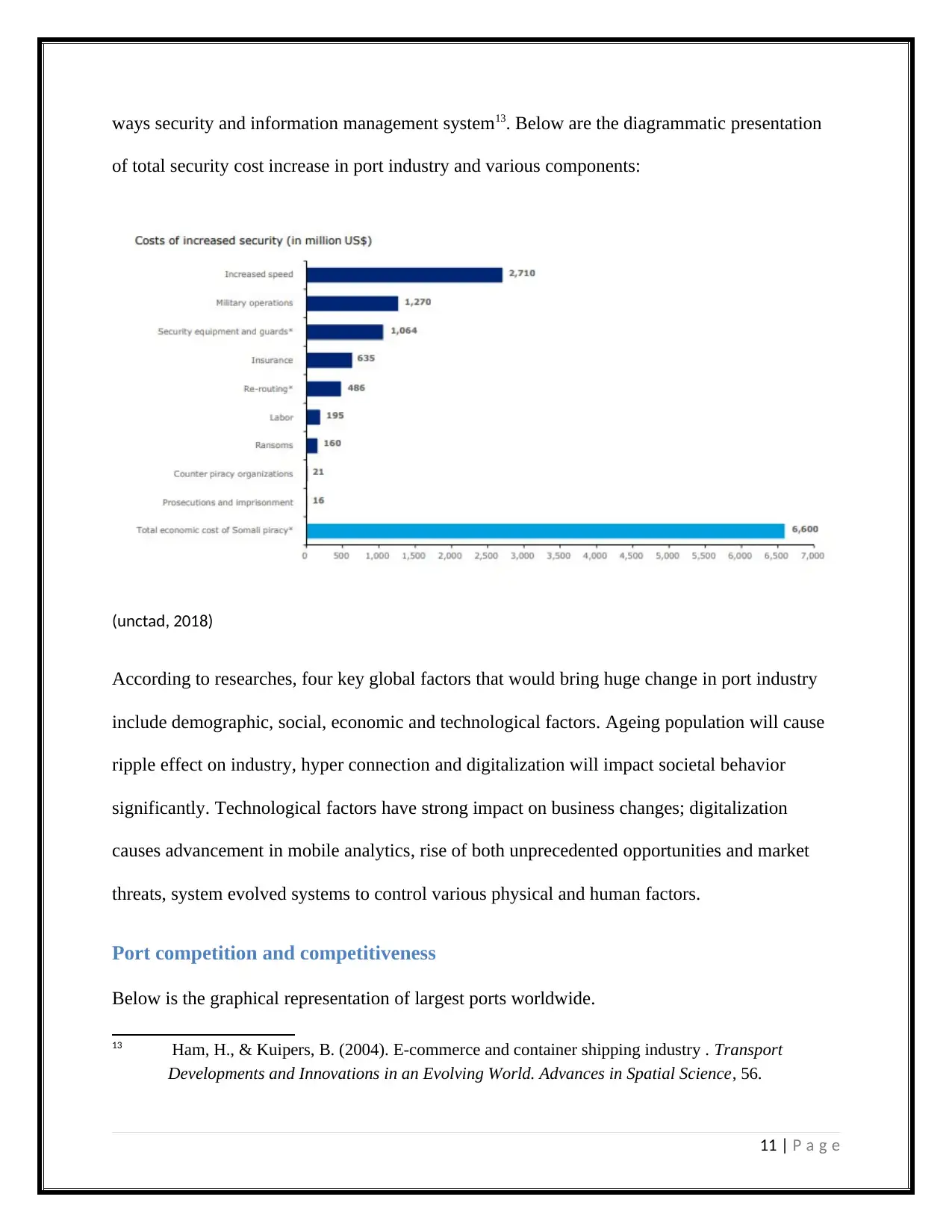
ways security and information management system13. Below are the diagrammatic presentation
of total security cost increase in port industry and various components:
(unctad, 2018)
According to researches, four key global factors that would bring huge change in port industry
include demographic, social, economic and technological factors. Ageing population will cause
ripple effect on industry, hyper connection and digitalization will impact societal behavior
significantly. Technological factors have strong impact on business changes; digitalization
causes advancement in mobile analytics, rise of both unprecedented opportunities and market
threats, system evolved systems to control various physical and human factors.
Port competition and competitiveness
Below is the graphical representation of largest ports worldwide.
13 Ham, H., & Kuipers, B. (2004). E-commerce and container shipping industry . Transport
Developments and Innovations in an Evolving World. Advances in Spatial Science, 56.
11 | P a g e
of total security cost increase in port industry and various components:
(unctad, 2018)
According to researches, four key global factors that would bring huge change in port industry
include demographic, social, economic and technological factors. Ageing population will cause
ripple effect on industry, hyper connection and digitalization will impact societal behavior
significantly. Technological factors have strong impact on business changes; digitalization
causes advancement in mobile analytics, rise of both unprecedented opportunities and market
threats, system evolved systems to control various physical and human factors.
Port competition and competitiveness
Below is the graphical representation of largest ports worldwide.
13 Ham, H., & Kuipers, B. (2004). E-commerce and container shipping industry . Transport
Developments and Innovations in an Evolving World. Advances in Spatial Science, 56.
11 | P a g e
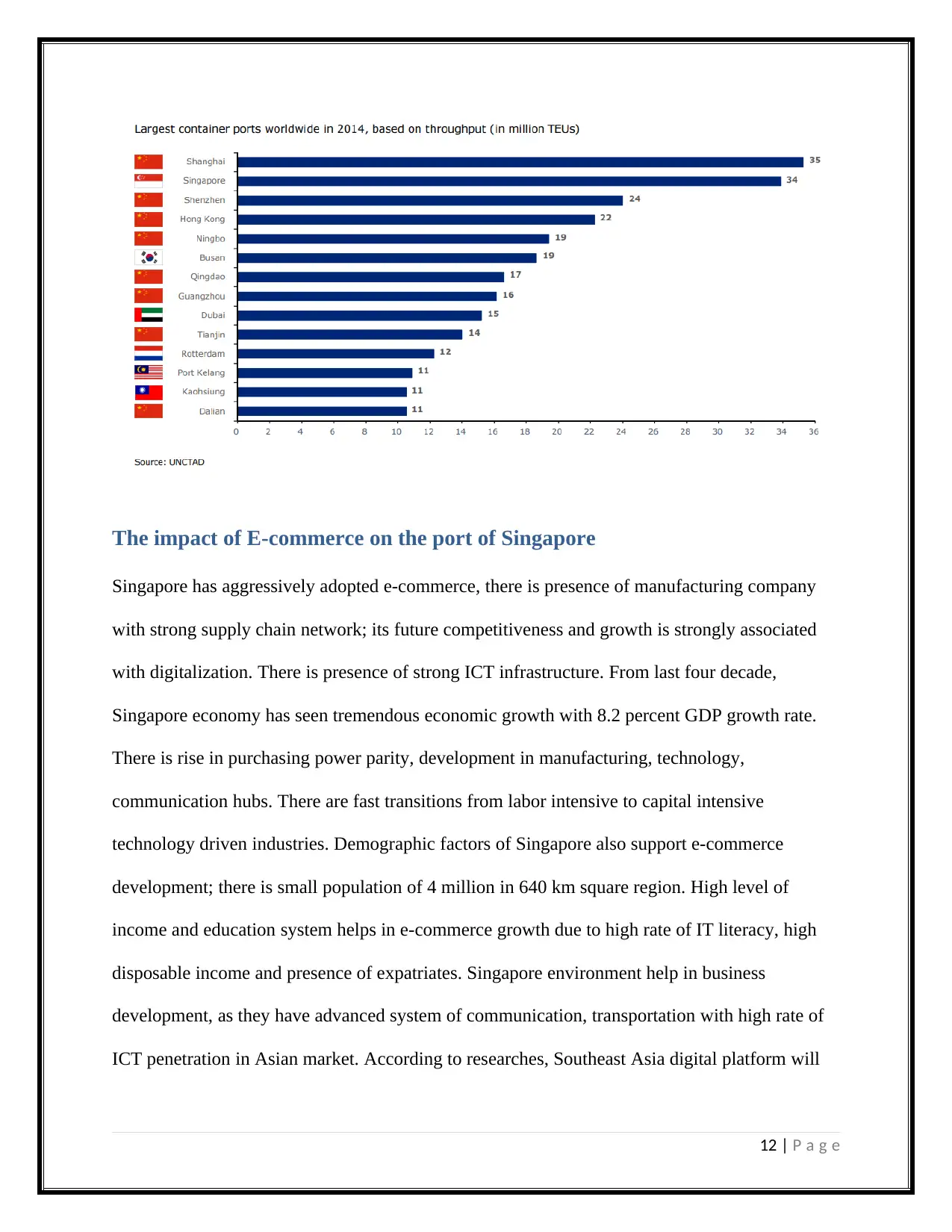
The impact of E-commerce on the port of Singapore
Singapore has aggressively adopted e-commerce, there is presence of manufacturing company
with strong supply chain network; its future competitiveness and growth is strongly associated
with digitalization. There is presence of strong ICT infrastructure. From last four decade,
Singapore economy has seen tremendous economic growth with 8.2 percent GDP growth rate.
There is rise in purchasing power parity, development in manufacturing, technology,
communication hubs. There are fast transitions from labor intensive to capital intensive
technology driven industries. Demographic factors of Singapore also support e-commerce
development; there is small population of 4 million in 640 km square region. High level of
income and education system helps in e-commerce growth due to high rate of IT literacy, high
disposable income and presence of expatriates. Singapore environment help in business
development, as they have advanced system of communication, transportation with high rate of
ICT penetration in Asian market. According to researches, Southeast Asia digital platform will
12 | P a g e
Singapore has aggressively adopted e-commerce, there is presence of manufacturing company
with strong supply chain network; its future competitiveness and growth is strongly associated
with digitalization. There is presence of strong ICT infrastructure. From last four decade,
Singapore economy has seen tremendous economic growth with 8.2 percent GDP growth rate.
There is rise in purchasing power parity, development in manufacturing, technology,
communication hubs. There are fast transitions from labor intensive to capital intensive
technology driven industries. Demographic factors of Singapore also support e-commerce
development; there is small population of 4 million in 640 km square region. High level of
income and education system helps in e-commerce growth due to high rate of IT literacy, high
disposable income and presence of expatriates. Singapore environment help in business
development, as they have advanced system of communication, transportation with high rate of
ICT penetration in Asian market. According to researches, Southeast Asia digital platform will
12 | P a g e
⊘ This is a preview!⊘
Do you want full access?
Subscribe today to unlock all pages.

Trusted by 1+ million students worldwide
1 out of 17
Related Documents
Your All-in-One AI-Powered Toolkit for Academic Success.
+13062052269
info@desklib.com
Available 24*7 on WhatsApp / Email
![[object Object]](/_next/static/media/star-bottom.7253800d.svg)
Unlock your academic potential
Copyright © 2020–2025 A2Z Services. All Rights Reserved. Developed and managed by ZUCOL.



